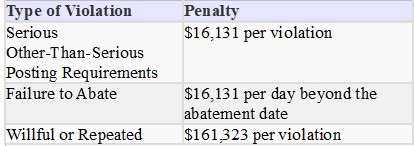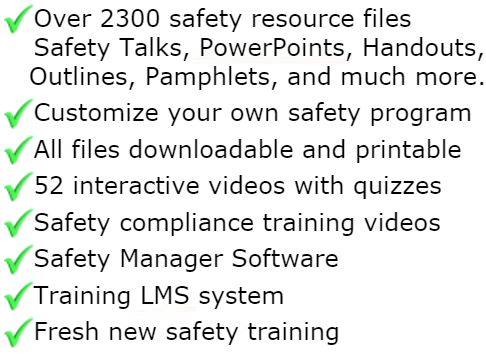
Material Handling & Storage Safety
For an effective materials handling and storage program, managers must take an active role in its development. First-line supervisors must be convinced of the importance of controlling hazards associated with materials handling and storing and must be held accountable for employee material handling safety training. Safe lifting is only one aspect of material handling; transporting the load safely is the other. How you move or carry and put down the load is just as important as how you pick it up.ently.
Moving, Handling, and Storing Materials
When manually moving materials, employees should seek help when a load is so bulky it cannot be properly grasped or lifted, when they cannot see around or over it, or when they cannot safely handle the load.
Handles or holders should be attached to loads to reduce the chances of getting fingers pinched or smashed. Workers also should use appropriate protective equipment. For loads with sharp or rough edges, wear gloves or other hand and forearm protection. In addition, to avoid injuries to the eyes, use eye protection. When the loads are heavy or bulky, the mover also should wear steel-toed safety shoes or boots to prevent foot injuries if he or she slips or accidentally drops a load.
All stacked loads must be correctly piled and cross-tiered, where possible. Precautions also should be taken when stacking and storing material. Stored materials must not create a hazard. Storage areas must be kept free from accumulated materials that cause tripping, fires, or explosions, or that may contribute to the harboring of rats and other pests.
When stacking and piling materials, it is important to be aware of such factors as the materials’ height and weight, how accessible the stored materials are to the user, and the condition of the containers where the materials are being stored. Non-compatible material must be separated in storage. Employees who work on stored materials in silos, hoppers, or tanks, must be equipped with lifelines and safety belts. All bound material should be stacked, placed on racks, blocked, interlocked, or otherwise secured to prevent it from sliding, falling, or collapsing. A load greater than that approved by a building official may not be placed on any floor of a building or other structure. Where applicable, load limits approved by the building inspector should be conspicuously posted in all storage areas.
When stacking materials, height limitations should be observed. For example, lumber must be stacked no more than 16 feet high if it is handled manually; 20 feet is the maximum stacking height if a forklift is used. For quick reference, walls or posts may be painted with stripes to indicate maximum stacking heights.
Used lumber must have all nails removed before stacking. Lumber must be stacked and leveled on solidly supported bracing. The stacks must be stable and self-supporting. Stacks of loose bricks should not be more than 7 feet in height. When these stacks reach a height of 4 feet, they should be tapered back 2 inches for every foot of height above the 4-foot level. When masonry blocks are stacked higher than 6 feet, the stacks should be tapered back one-half block for each tier above the 6-foot level. Bags and bundles must be stacked in interlocking rows to remain secure. Bagged material must be stacked by stepping back the layers and cross-keying the bags at least every ten layers. To remove bags from the stack, start from the top row first. Baled paper and rags stored inside a building must not be closer than 18 inches to the walls, partitions, or sprinkler heads.
Boxed materials must be banded or held in place using cross-ties or shrink plastic fiber.
Drums, barrels, and kegs must be stacked symmetrically. If stored on their sides, the bottom tiers must be blocked to keep them from rolling. When stacked on end, put planks, sheets of plywood dunnage, or pallets between each tier to make a firm, flat, stacking surface. When stacking materials two or more tiers high, the bottom tier must be chocked on each side to prevent shifting in either direction. When stacking, consider the need for availability of the material. Material that cannot be stacked due to size, shape, or fragility can be safely stored on shelves or in bins.
Structural steel, bar stock, poles, and other cylindrical materials, unless in racks, must be stacked and blocked to prevent spreading or tilting. Pipes and bars should not be stored in racks that face main aisles; this could create a hazard to passers-by when removing supplies.
Material Handling with Conveyors
When using conveyors, workers’ hands may be caught in nip points where the conveyor medium runs near the frame or over support members or rollers; workers may be struck by material falling off the conveyor; or they may become caught on or in the conveyor, being drawn into the conveyor path as a result.
To reduce the severity of an injury, an emergency button or pull cord designed to stop the conveyor must be installed at the employee’s workstation. Continuously accessible conveyor belts should have an emergency stop cable that extends the entire length of the conveyor belt so that the cable can be accessed from any location along the belt. The emergency stop switch must be designed to be reset before the conveyor can be restarted. Before restarting a conveyor that has stopped due to an overload, appropriate personnel must inspect the conveyor and clear the stoppage before restarting. Employees must never ride on a materials handling conveyor. Where a conveyor passes over work areas or aisles, guards must be provided to keep employees from being struck by falling material. If the crossover is low enough for workers to run into it, the guard must be either marked with a warning sign or painted a bright color to protect employees.
Screw conveyors must be completely covered except at loading and discharging points. At those points, guards must protect employees against contacting the moving screw; the guards are movable, and they must be interlocked to prevent conveyor movement when not in place.
Flammable Material Handling & Storage
In adhering to fire safety precautions, employees should note that flammable and combustible materials must be stored according to their fire characteristics. Flammable liquids, for example, must be separated from other material by a fire wall. Also, other combustibles must be stored in an area where smoking and using an open flame or a spark-producing device is prohibited. Dissimilar materials that are dangerous when they come into contact with each other must be stored apart.
Ergonomics of Material Handling
Ergonomics is defined as the study of work and is based on the principle that the job should be adapted to fit the person, rather than forcing the person to fit the job. Ergonomics focuses on the work environment, such as its design and function, and items such as design and function of workstations, controls, displays, safety devices, tools, and lighting to fit the employees’ physical requirements and to ensure their health and well being. Ergonomics includes restructuring or changing workplace conditions to make the job easier and reducing stressors that cause cumulative trauma disorders and repetitive motion injuries. In the area of materials handling and storing, ergonomic principles may require controls such as reducing the size or weight of the objects lifted, installing a mechanical lifting aid, or changing the height of a pallet or shelf. Although no approach has been found for totally eliminating back injuries resulting from lifting materials, a substantial number of lifting injuries can be prevented by implementing an effective ergonomics program and by training employees in appropriate lifting techniques.
In addition to using ergonomic controls, there are some basic safety principles that can be employed to reduce injuries resulting from handling and storing materials. These include taking general fire safety precautions and keeping aisles and passageways clear.
Employee Hazard & Safety Training
Employee Hazard & Safety Training
A formal training program to allow employees to recognize and avoid materials handling hazards is recommended. Instructors should be well-versed in matters that pertain to safety engineering and materials handling and storing. The content of the training should emphasize those factors that will contribute to reducing workplace hazards including the following:
• Alerting the employee to the dangers of lifting without proper training.
• Showing the employee how to avoid unnecessary physical stress and strain.
• Teaching workers to become aware of what they can comfortably handle without undue strain.
• Instructing workers on the proper use of equipment.
• Teaching workers to recognize potential hazards and how to prevent or correct them.
• Awareness of health risks to improper lifting.
• Knowledge of the basic anatomy of the spine, the muscles, and the joints of the trunk, and the contributions of intra-abdominal pressure while lifting.
• Awareness of individual body strengths and weaknesses— determining one’s own lifting capacity.
• Recognition of the physical factors that might contribute to an accident and how to avoid the unexpected.
• Use of safe lifting postures and timing for smooth, easy lifting and the ability to minimize the load-moment effects.
• Use of handling aids such as stages, platforms, or steps, trestles, shoulder pads, and handles.
• Knowledge of body responses—warning signals—to be aware of when lifting.
Keep it Short. Most safety meeting topics can be completed in 15 to 20 minutes. Don't try to fill the time time.
Nuts & Bolts. Use a basic outline to keep your session flowing. An outline need only be reminder points to ensure you have covered all required areas. This will also help with a smooth opening and closing.
• Introduce yourself
• Introduce the topic
• Present your facts
• Discuss the applicable hazards
• Discuss hazard control
• Demonstrate the "How To"
• Ask questions during session
• Ask "What if...."
• Start a discussion• Summarize key points
Check Your Attitude! People will quickly pick up on the fact if you are just going through the motions because management says you must have a safety meeting. They will have less respect for you if you do not control the session as they know you should. Be positive, be animated.... allow your professional approach to catch on with others.
All materials in the members area for this topic index

GET INSTANT ACCESS
to THE MEMBERS LIBRARY
Safety materials created by safety professionals.
Access to the Safety Manager software.
Wide variety of safety videos and courses.
**Brand New** Safety Training Management System
Pre-Made Safety Materials Ready For Use
Created by experienced safety professionals & risk consultants. Saving you time, money, and risk of injuries.
95% of the work already done.
Below are the maximum penalty amounts, with the annual adjustment for inflation, that may be assessed after Jan. 15, 2024. (See OSHA Memo, Jan. 8, 2024).

**New OSHA HEAT 90 DAY**
>>Download Free HERE<<
**New 2024 OSHA 300 Form**
>>Download Free HERE<<
**Brand New**
Free with full membership subscription
Training LMS System
Ask The Safety Consultant
Safety Equipment Deal Finder

“SafetyInfo.com is the first go-to website for safety professionals and companies to use in establishing a solid safety program"
-Mike McKenzie, Certified Safety & Health Manager (CSHM), McSafety Solutions™
Note: You must have a full subscription to the Safety Library in order to use this material. Any use outside of your organization, for resell, or without an active membership is strictly prohibited and may result in prosecution under copyright infringement laws. Please contact us first, if you would be interested in reselling or using our materials for reproduction.
Inside the Members Library
Topic Index
Accident Prevention
Air Quality
Asbestos
Bloodborne Pathogens
Boilers
Chemical Safety
Compressed Gas
Confined Space
Construction
Construction Worksite
Cranes & Slings
Driver / Fleet Safety
Drug Free Workplace
Electrical
Emergency Management
Engineering Safety
Environmental
Equipment
Ergonomics
Fall Protection
Fire Safety & Prevention
First Aid
Flammable Materials
Forklifts
Hazard Communication
Hazardous Materials
Hearing Protection
Heat Stress
Hot Work
Housekeeping
Job Safety Analysis
Laboratory
Ladders
Lead
Lockout-Tagout
Machinery & Equipment
Material Handling
MSDS (SDS)
Medical & First Aid
Occupational Health
Office Safety
Off the Job Safety
Personal Protection
Process Safety
Record Keeping
Respiratory Protection
Silica Safety
Rules & Policies
Signs & Labels
Slips, Trips & Fall
Training
Terrorism Programs
Tool Safety
Vehicle & Driver
Violence Programs
Welding & Hot Work
Training Videos
Library Index
Training Materials
Videos/Courses
Talks
Articles
PowerPoint
Handouts
Training Overheads
Quizzes
Supervisor Briefs
Management Briefs
Safety Sessions
2 Minute OSHA Safety Talks
Pamphlets
First Aid Training
Supervisor Training
Hazardous Materials
Bomb Threat
Crossword Puzzles
Biological Agents
Forms & Documents
Forms
Checklists
Audit Guides
Inspections Guides
Signs & Labels
Environmental Audit Guides
Recordkeeping - OSHA 300
Sign & Label Maker
Safety Management Resources
Safety Manuals/Written Programs
Ergonomic Programs
Emergency Plans
Process Safety Management
Construction Safety
Occupational Health
Environmental
Topic Sheets
DOT Fleet-Driver
Hazardous Materials
Chemical Safety
Drug Free Workplace
Terrorism Programs
Development Guides
Safety Manager Software
Safety References & Graphics
Technical Safety Information
Posters
Topic & Fact Sheets
Development Information
Job Specific Safety Rules
Terrorism
Calculators
Safety Comic Strips
New Safety Training System
Schedule and train your employees with our materials. Add unlimited amount of employees. Record all progress and issue certificates. For group and individual training sessions.

